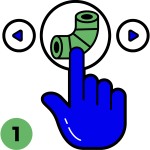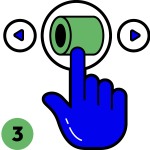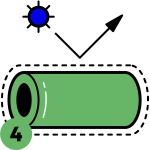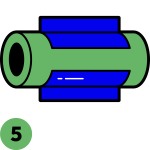
|
|
| ||||||||||||||||||||||||||||||
| "If there be any among us who [disagree], let them stand undisturbed as monuments of the safety with which error of opinion may be tolerated, where reason is left free to combat it." Thomas Jefferson, March 4, 1801 |
Clear PVC Pipe & Acrylic Tube |
Sch 40 White PVC Plumbing Pipe |
Sch 80 Gray PVC Plumbing Pipe |
Furniture Grade Glossy White Pipe |
PVC CTS CPVC Pipe |
Thinwall PVC Pipe |
Metric PVC Pipe |
|
Water Flow Chart #1 The chart below takes into consideration the potential damage from hydraulic hammer (shock) and noise considerations due to excessive fluid velocity. For more detailed information click here for our pipe selection based on pipe size and flow requirement Nomograph. You can flow more than what is shown in the chart (see Chart #2 below) however, you may run into problems if you do.
IMPORTANT: The flow ratings in the charts below are for Rigid PVC Pipe. Reduce flow by 3% (Multiply by .97) for flow going through Flexible PVC Pipe.
Water Flow Chart #2
Water Flow Chart #3
|
There are now 3 charts and one formula on this page showing water flow through a pipe. These 3 charts come from 3 different sources, and they all are just general guidelines. and should not be relied on as a precise source for information or as a substitute for engineering. The data between them does vary. In the chart to the left is a general guideline for how much liquid a pipe of specific size can flow in GPM (Gallons Per Minute) & GPH (Gallons Per Hour.) There are three columns. (Well there are really six, but each colum is shown in Gallons per minute, and then again as Gallons per Hour.) The first set of columns would be the minimum you would expect for the pipe size shown using nothing but gravity in a low head pressure situation to power the flow. The 2nd set of columns show what you can expect using an average pump with a pressure from 20 to 100psi. The 3rd set of columns is the maximum flow based on maximum recommended velocity of the liquid in the pipe. You may exceed this, but you will have to contend with excessive noise and exceedingly high inertial impacts. (I.e. Possible system failure due to hydraulic hammer effects.) This is a very general guide and is subject to many variables. Pressure, noise allowance, bends, fittings, viscosity, etc. affect how much liquid will flow through a pipe of given size. If you can accept more noise and have higher pressure, you can pump more at the risk of system failure. If you have a lot of bends and fittings you will flow less. The flow rates shown should not produce unacceptable noise, however, many variables affect noise, so this is no guarantee that the system will be noiseless. Sometimes experimentation is the only sure way to know if a system will be noisy or not. The flow rates shown are for water, with viscosity of 1. Higher viscosity liquids will flow less, lower viscosity liquids may flow more. You can use the Hazen-Williams equation below to calculate the exact flow loss through a pipe. Pipe Size vs Flow Nomograph The nomograph (link above) allows you visually see the effect of pipe size and flow rates. You can click on the link and print it out to make it more usable to you. You should size your pipe so that your flow velocity stays in the green or yellow range. The green range is safest, most efficient and will produce little to no noise. Flow velocities in the yellow range may be noisy and have additional back pressure. Flow velocities in the red are not recommended because of the risk of hydraulic shock and pipe/fitting/joint & pump failure. Note: Back pressure (restriction) is exponentially dependent on flow velocity. For example in a 1" pipe going from a flow velocity of 2 ft/sect (about 5gpm) to a flow velocity of 3.86 ft/sec (about 10gpm) will increase back pressure by 300%. Going to a flow velocity of 7.71ft/sec (about 20gpm) will increase back pressure by 1300%! These figures are for straight pipe only! The effect of putting direction changes in will compound the back pressure even more and could even result in failure of the system or burning up the pump. You will never be hurt by going to a bigger pipe and will gain by using less electricity due to a more efficient system which may offset the initial price difference for the larger pipe. Find your flow in the first column (GPM) and then select the pipe size you want in the second column (pipe, ID in inches.) Draw a straight line between them all the way to the last column. If the line ends up in the green you are good. If it ends in the yellow or red, increase the pipe size until your line ends in the green (best) or yellow (just okay) area. Friction Loss Further Detailed Information If you really want to get technical and calculate the exact friction loss through PVC and CPVC pipe you can use the Hazen-Williams equation as expressed below for water: f = 0.2083 (100/c)1.852 q1.852 / dh4.8655 where f = friction head loss in feet of water per 100 feet of pipe (fth20/100 ft pipe) q = volume flow (gal/min) dh = inside diameter (inches) c = a constant for internal pipe roughness. 150 is the commonly accepted value for PVC and CPVC pipe. You can also print out and use the Nomograph courtesy of Plastics Pipe Institute, a division of The Society of The Plastics Industry. (Note: You normally want to keep your flow velocity under 12 feet per second for 4" and under and 5 feet/second for 5" and above to avoid hydraulic shock.) What about fittings? How do they affect flow? See our Friction loss due to pvc pipe fittings chart. Compared to other materials on construction for pipe, thermo-plastic pipe smoothness remains relatively constant throughout its service life. If you are flowing something other than water, you'll have to adjust the formula for the viscosity of the liquid you are flowing. Note: One of the benefits of using Flexible PVC pipe is being able to make long gradual bends instead of using fittings which will allow more flow with less noise, less back pressure, and less load on the pump. In other words, a more efficient system! |
|||||||||||||||||||||||||||||||||||||||||||||||||||||||||||||||||||||||||||||||||||||||||||||||||||||||||||||||||||||||||||||||||||||||||||||||||||||||||||||||||||||||||||||||||||||||||||||||||||||||||||||||||||||||||||||||||||||||||||||||||||||||||||||||||||||||||
|
Home Contact SIGN UP FOR OUR EMAIL LIST - for free gifts every month, discount codes and product announcements. |
FAQ Application Guidelines Technical Articles Technical References Technical Videos Prop 65 Warning |
Privacy Statement Terms & Conditions Warranty Disclaimer Shortcuts Shopping Cart Sitemap |
Our Charities & other important issues. Plumbing & Irrigation Directory Location:18.118.184.237 Links Blog KeyCDN, the most cost effective CDN on the net. |
| All text, images, layout and design Copyright 2002 - 2024 FlexPVC ®, PVC Distributors LLC. - - - FlexPVC ® is a Registered Trademark of PVC Distributors LLC | |||










